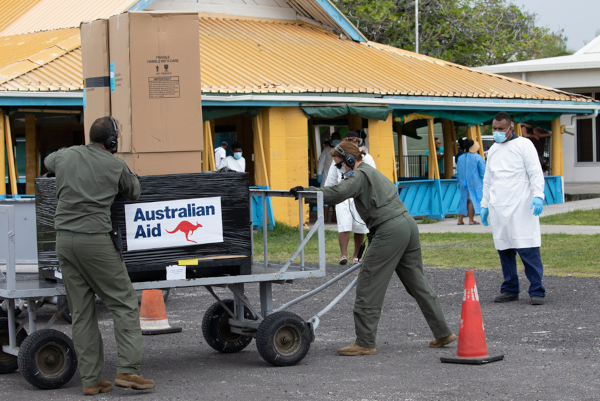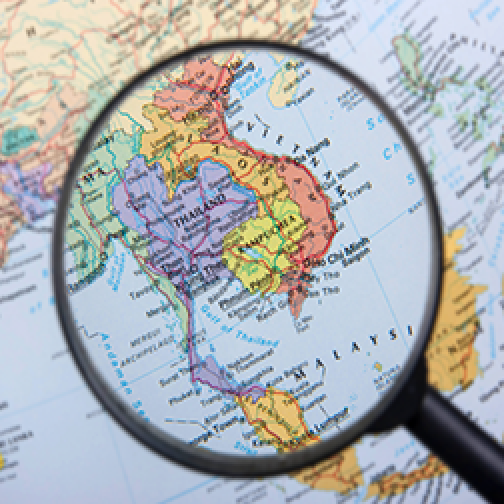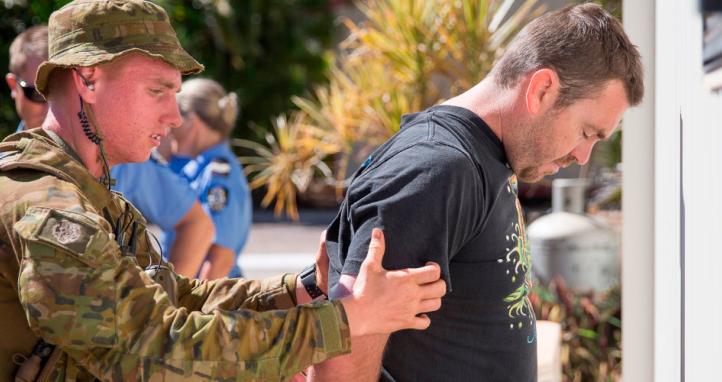Facts and figures
| GDP | $USD 0.63 billions |
| GDP per capita | $USD 6,113 |
| Currency | TVD (Tuvaluan dollar $) , AUD (Australian dollar $) |
The ‘Know Your Region’ series is designed to support unit and individual professional military education on the Indo-Pacific region. It’s important for all serving members of our military to have a foundational knowledge of the countries and issues in the Indo-Pacific.
On this page:
- Summary
- Trade
- Major industries
- The .tv domain and digital royalties
- Remittances and seafarers’ earnings
- Official development assistance (ODA) and grants
- Other income streams
- Economic partnerships
Summary
Tuvalu is one of the world’s smallest national economies by output and population, yet its economy is unusually complex for its size. Annual GDP in 2024 was roughly US $56 million, and the country depends heavily on a handful of concentrated revenue streams:
- Fisheries licensing and access fees (payments from foreign fleets for rights to fish in Tuvalu’s EEZ).
- Government services and public administration (public sector is a major employer).
- Remittances and seafarers’ earnings (Tuvaluans employed on international merchant vessels and abroad).
- Revenue from the .tv top-level domain and other telecommunications fees.
- Small-scale agriculture (copra, root crops) and fisheries for local consumption, plus very limited tourism.
The private sector is small and dominated by small retail shops, local service firms, and a handful of importers. Tuvalu uses Australian currency but also issues its own coins. There is a single bank, a joint government-commercial venture which acquired an ATM in early 2025.
Trade
Tuvalu runs a large trade deficit and relies on foreign aid, the Tuvalu Trust Fund, and donor-financed projects, for budgetary support and capital investment. Tuvalu’s exports are very small in value terms, often measured in the low single-digit millions of US$ annually. Exports consist of copra, small quantities of fish and shell products, and some re-exports. Major export partners include nearby Asian countries that buy processed copra and canned fish.
By contrast, Tuvalu imports the bulk of its physical goods, which includes foodstuffs, fuel, construction materials, machinery, vehicles, and manufactured consumer goods. Imports are typically dozens of times larger than exports. To make up the difference, Tuvalu relies on other income streams to stay afloat.
Major Industries
Tuvalu’s largest revenue source in recent years has been access fees and licensing income from tuna fisheries in its EEZ. In 2023, revenue from fisheries licences was US$43 million. This heavy dependence on the EEZ makes Tuvalu economically vulnerable to shifting tuna stocks and global fishing arrangements. Recent reporting indicates a decline in some licensing receipts as fish move beyond Tuvalu’s traditional fishing grounds.
The .tv domain and digital royalties
Tuvalu benefits from licensing its country code top-level domain .tv, which is commercially valuable because of its media connotation. Revenue from .tv deals has varied over time depending on registry arrangements, but the domain has been an important non-tax government revenue source since it was created. Multiple sources have estimated millions of US dollars per year. Older major deals in the late 1990s delivered large up-front payments, and more recent registry agreements produce recurring royalties.
Remittances and seafarers’ earnings
Remittances from Tuvaluans working abroad, particularly seafarers on international merchant vessels and seasonal workers in Australia and New Zealand, contribute to household incomes and foreign-exchange inflows. World Bank and national data show remittances in the order of 4-7% of GDP in recent years, and seafarers’ wages have been estimated in the order of several million Australian dollars annually.
The Tuvalu Trust Fund and sovereign savings
Tuvalu established the Tuvalu Trust Fund (TTF) in 1987 as a stabilisation and savings vehicle. The fund is professionally managed and is intended to provide a steady income stream to supplement government revenue. Public reporting and independent summaries indicate the TTF’s market value has grown over time. Recent accounts estimate the fund’s assets in the low hundreds of millions of Australian dollars, making it a critical buffer for budget shortfalls and for ensuring inter-generational equity.
Official development assistance (ODA) and grants
A substantive share of public spending comes from foreign aid – grants and concessional financing for health, education, adaptation, infrastructure, and budget support. Major bilateral donors include Australia, New Zealand, Japan, Taiwan, the European Union, the United States, and multilateral donors including the World Bank, ADB, GCF, and UN agencies. International donors have enabled large projects such as climate adaptation and telecoms.
In 2024 Australia sharply increased its support to Tuvalu under a new bilateral arrangement. The Australia-Tuvalu bilateral package announced in 2024 included A$110 million in commitments to help fund an undersea cable, land reclamation, and security.

No. 35 Squadron deliver humanitarian and disaster relief stores from a C-27J Spartan aircraft in Tuvalu – Defence Image Library
Other income streams
The public sector is a major employer and provider of services (education, health, utilities). Because private enterprise is small, government jobs are a central source of formal employment, which links public wages directly to fiscal health and external funding flows.
Agriculture is largely subsistence with some copra production sold commercially. Tourism is minimal compared with other Pacific islands because of limited air access, small scale accommodation, and high travel costs; niche eco- or cultural tourism is available but not a big income earner.
Economic Partnerships
Australia and New Zealand are Tuvalu’s most important development partners. They provide bilateral aid, training, seasonal and labour mobility pathways, technical assistance, and security support.
Multilateral lenders, such as the World Bank, Asian Development Bank, Green Climate Fund, and UN agencies provide project finance and technical assistance. Tuvalu has actively used these channels to finance coastal adaptation, communications infrastructure, healthcare, and education projects.
For more information on Tuvalu’s economy, see the resources below:
Videos
- Tuvalu Fisheries Authority | Te Vaka Taagia o Tuvalu
- How the World’s Smallest Economy Survives – Tuvalu’s Hidden Story - YouTube
Articles
Know your region
Know Your Region series gives you a shortcut to understanding other nations in the Indo-Pacific region.









